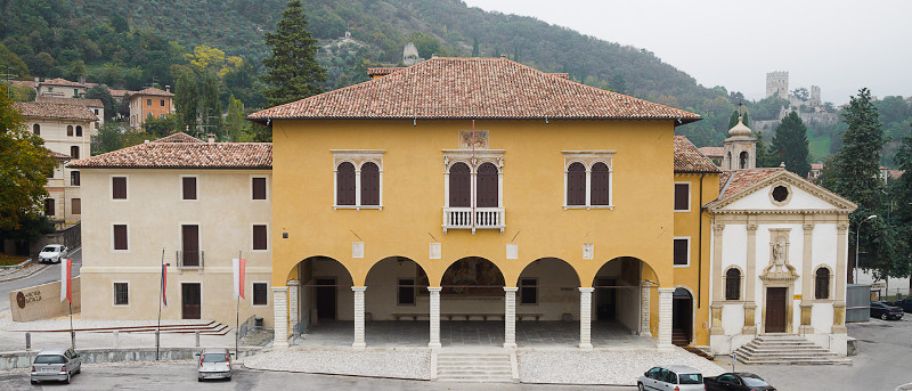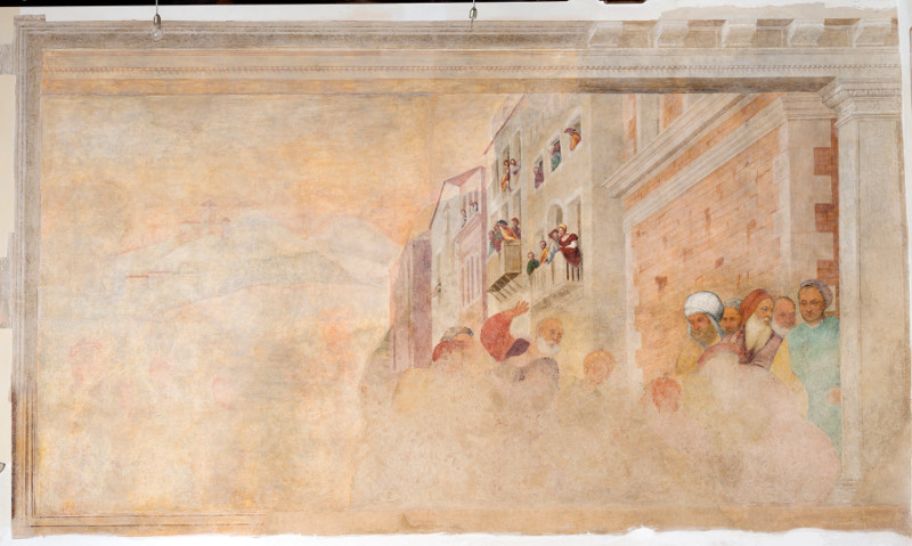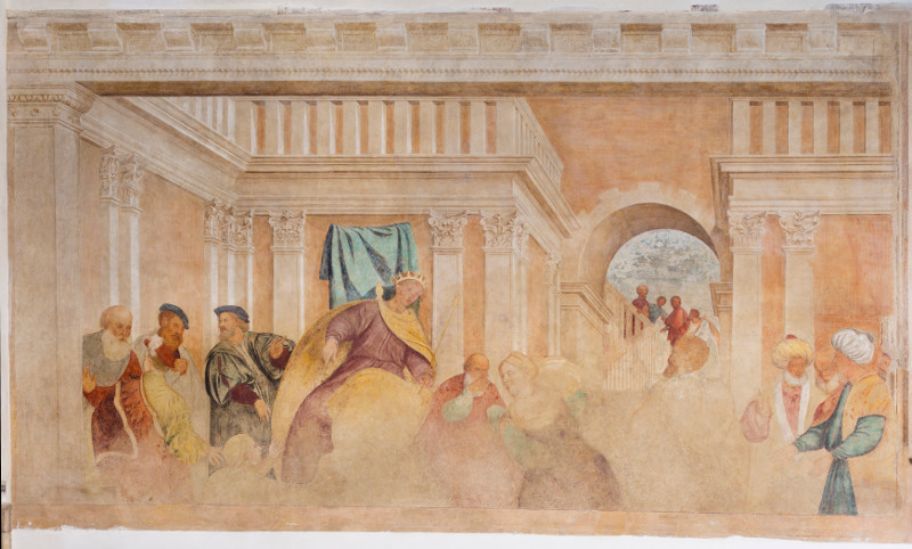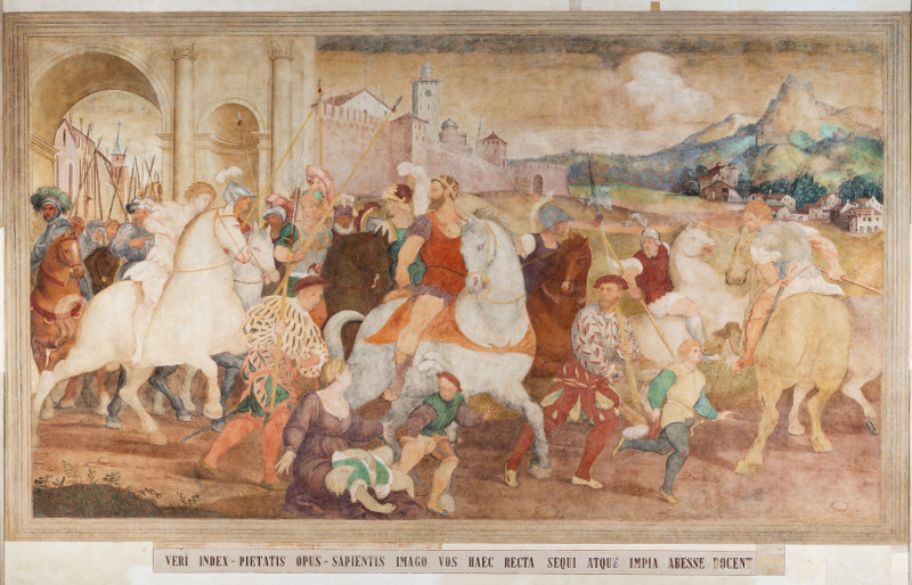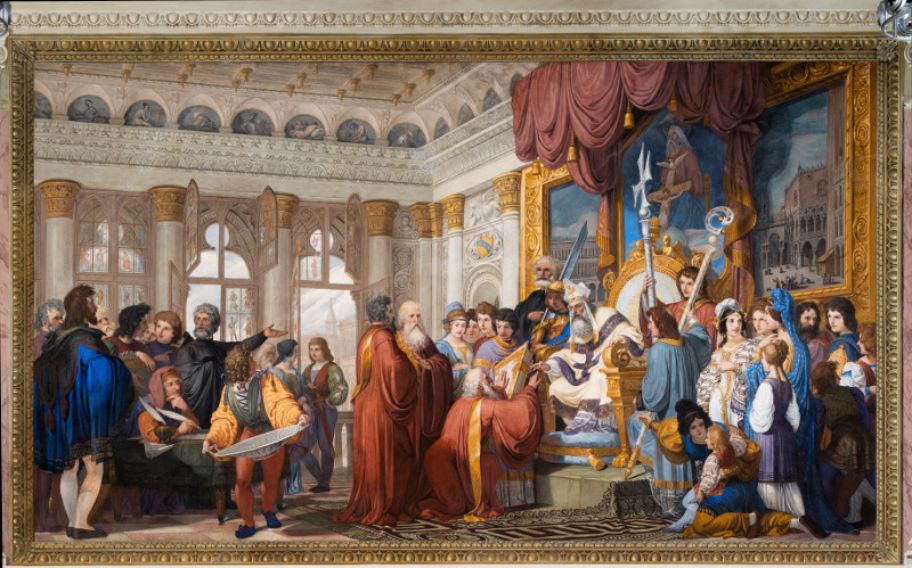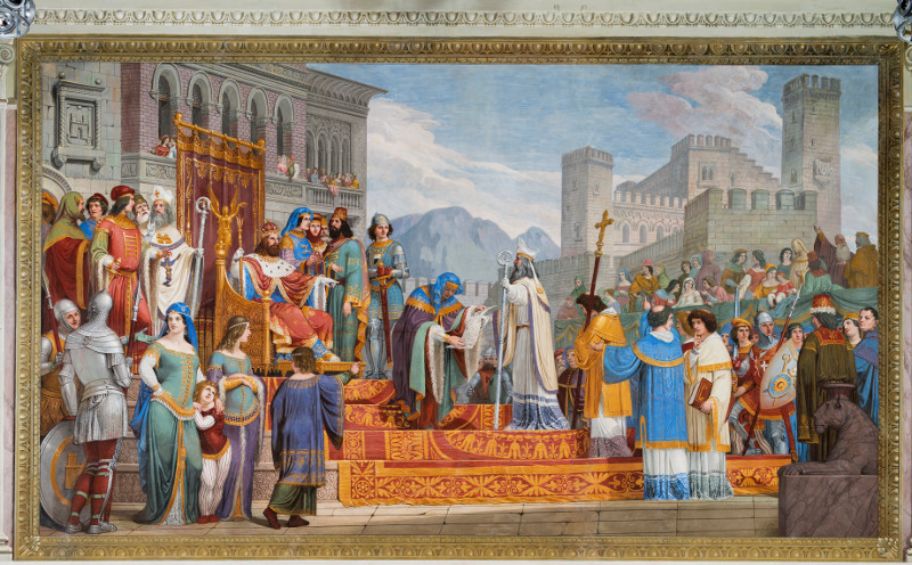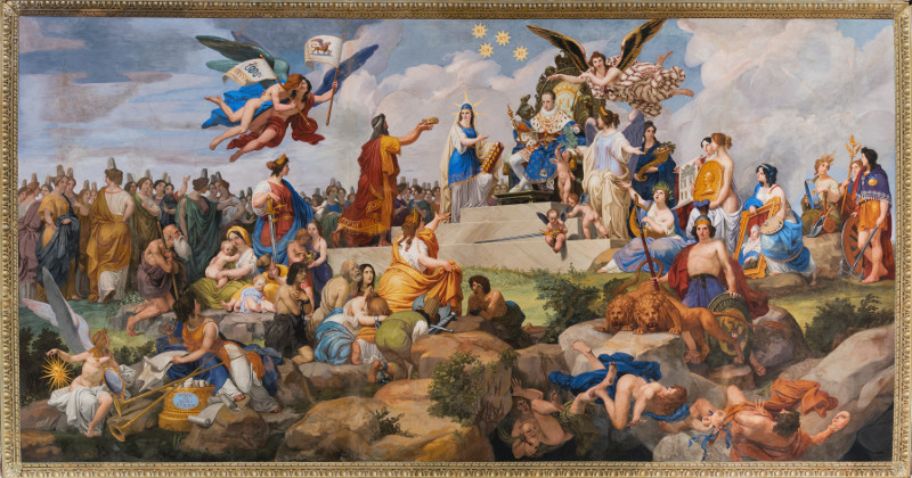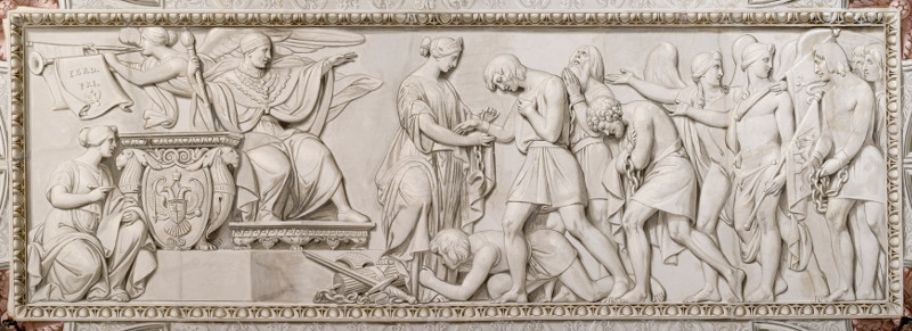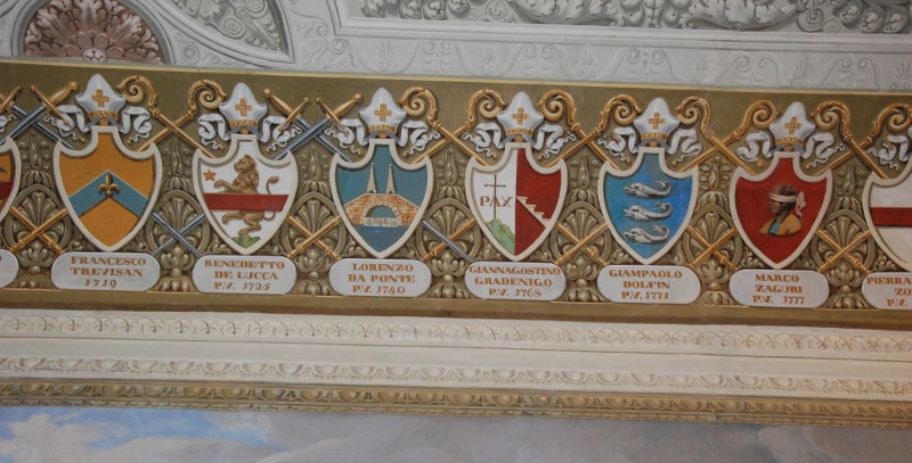Scopri il palazzo
Il palazzo: l'archittettura, gli spazi e la storia
History
The building was ordered by the bishop of Ceneda Giovanni Grimani (ruling from 1520 to 1534 and again from 1540 to 1545); the project is commonly attributed to Jacopo Sansovino, the official architect of the Republic of Venice. On the second floor, we can find the major council hall, where the administration body of the city used to meet. It is decorated with frescos by Giovanni De Min and Paolo Pajetta. All the coats of arms of the bishops surround the upper side of the walls. The Loggia was frescoed by Pomponio Amalteo. In 1866, with the unification of Serravalle and Ceneda into Vittorio Veneto, the building lost its political importance and became an archive until 1938, when Luigi Marson donated to the city all his war finds and established the Museo della Battaglia.
Architecture
The building is next to the deconsacreted church of Saint Paul Apolstle and Saint Francis of Assisi. The front- made in the XVI century- is covered in amber monocrome plaster. The lower part haas a loggia with three frescos by Pomponio Amalteo and five openings on an esastylon, on the higher part it has a balcony with a representation of the Saint Mark's lion. Near the antrance therer are some war finds from World War I. The ground floor contains the loggia, an exposition about life in trenches and the bookshop. The exposition is completed on the second floor where it deals with the occupation of Vittorio Veneto by Austro-Hungarians, and the Armeria Marson, a collection of weapons which was the first collection of the museum. On the second floor there is the Major Council Hall and an exhibition which recalls the way the museum was first organized.
San Paoletto
The chapel of "S. Paolo Al Piano" is a building next to the museum. Some people think that it could be dated back to the seventeenth century, because of the tradition of adding a small church to a city hall, but on the other hand it could have been built in the eighteenth century, because of its slightly baroque style.
It hosted two confraternities from 1720 to 1850, when the chapel was abandoned.
During the Great War it was used as a gathering point for the students, because the theological college was turned into a hospital.
In 1920, after the repairs, the city council left that property to the parish of "S. Maria Assunta".
La loggia: gli affreschi di Pomponio Amalteo
Daniel's trial
The fresco on the left portrays a biblical story about prophet Daniel's trial. The prophet, guided by the Holy Ghost, frees from blame a girl wrongly accused of adultery.
Salomon's trial
The fresco shows how the king of Israel recognizes the real mother of a child after a dispute between two alleged mothers.
Traian's trial
The fresco shows a woman holding a dead baby. The child has been killed by the emperor's own son who accidentally stomped on him with his horse. The mother demands justice from the emperor and he tells his son that from then on he will have to consider that woman as his mother.
Renovation Works
The paintings we can see in the three sidewalls of the loggia (1537-1538) have been grievously damaged by the weather conditions over the centuries. The figurative squares were originally carried out in a plaster made of lime and sand.
The "fresco" is a technique of mural painting executed upon freshly-laid plaster. Water is used as the vehicle for the mineral pigments to merge with the plaster, so that the painting becomes an integral part of the wall.
In the 19th century overall renovation works - mainly consisting of pictoral retouching and filling up of cracks - had been effected in the loggia. The latest restauration (2012-2014) was more of a preservative work and it primarily operated selectively with a polishing plan.
Pomponio Amalteo
Pomponio Amalteo was born of Leonardo della Motta and Natalia Amalteo in Motta di Livenza in 1505.
Since he was young, he showed a particular disposition for painting, which he has developed when he met his master Giovanni Antonio de' Sacchis, also known as "Pordenone".
In 1539, Amalteo bought a palace in San Vito al Tagliamento, where he held some political offices and worked for the rest of his life.
He died on March 9th, 1588, in his beloved San Vito.
Amalteo made numerous paintings and frescoes in palaces, mansions and castle dwellings. He was quoted as a gifted painter by the prominent Italian artist and biographer Giorgio Vasari, around 1550.
Many other artists followed his pictorial school until the first decades of the 17th Century.
Frescoes
Ceneda’s inhabitants repel Guecello da Camino’s assault.
It’s said that in 1316 count Guecello da Camino tried to take Ceneda fortress by force, but he failed. So on the 8^th June he attacked it one more time, but after the second failure he let out his wrath in the nearby villages. This is the subject of the fresco that takes up the northern wall of Ceneda Civic Hall. The scene takes place at the foot of San Martino castle. Two rival protagonist stand out in the fresco: on the right Guecello da Camino, who calls his men to assemble with the sword and turns back to see if the enemy’s troops are following him. On the left Adalgero, victorious gives his back to visitors and points the enemies with his sword.
Francesco Ramponi infeoffs procurators of St. Mark
On October 1337 Bishop Francesco Ramponi gives Serravalle and its lineoffs to the Procurators of St. Mark. He occupies the central part of the fresco, set in the Palace of Dalla Riva’s family in Venice. The other characters on the scene are some Ministers, the priest of Serravalle, a pair of lovers, a group of women with a child and a notary responsible for trascribing the act. There are some visible contraddictions, both both chronological and geographical: the room details and the clothing are more consistent with the 15th Century style than with the 14th one. Moreover, the view on St. Mark Square from the windows is not so realistic. Such a view wouldn’t be possible from Palazzo Dalla Riva.
Emperor Carlo IV confirms his feud to the Bishop Gualberto d'Orgueil.
In 1354 the Bishop of Ceneda visits Emperor Carlo IV, who's staying in Feltre, to reconfirm his own ancient priviledges.
During this stay the Emperor is also visited by the ambassadors of many renowed families, among whom Visconti, Estensi and Scaligeri, recognizeable by their heraldic bearings. The castle in the background is the castle of Alboino, also known as the Castle of Feltre.
The emperor’s apotheosis.
The fresco located on the ceiling represents Ferdinand I’s coronation as King of the Lombardo Veneto. To the right of the throne there are Peace, Abundance, Poetry, the Fine Arts group (Architecture, Sculpture and Painting), Agriculture, Industry, Trade and Strength; beside them three geniuses are seen maintaining order among the characters. To the left of the emperor there are Religion, Law, Mercy, Justice, History, the Truth genius and up in the sky two geniuses representing Lombardia and Veneto entangled in a brotherly hug because they’ve been reunited under the same kingdom by Ferdinand. In the background there are thirty-three women, who symbolize the cities of the new reign.
Ferdinand I concedes an armistice
The main character is Mercy, who frees the prisoners from their chains. Under the throne there are the weapons that represent the seriousness of the prisoners’ crimes; this is supposed to be a reminder to these people not to repeat those actions.
Ferdinand i gives awards to deserving citizens.
It refers to the event of September 6th 1838, when the emperor issued an armistice for all prisoners. It represents the moment when Ferdinand I gives medals to those who are worthy of them.
Allegory of Vittorio Veneto.
The ceiling of the Sala del Mito is decorated with a portrayal of a woman who symbolizes the city of Vittorio Veneto. The children with her represent Ceneda and Serravalle.
Bishops
Francesco Ramponi (?-1349).
Born in Bologna, he was elected Bishop in 1320 and he temporarily stayed at the Caminesi residence in Serravalle. After the death of the last member of the family, on behalf of the Caminesi, he enfeoffed the Procurators of St. Mark. He served for 28 years as a Bishop, until his death in 1349.
D'Orgueil
Born in Aquitaine, Gualberto d'Orgueil was elected Bishop of Ceneda on November 13th 1349. With his visit to the Emperor in 1354 he had his priviledges reconfirmed with the addition of the title of “Prince".
Marino Grimani (1488/89-1546/47).
Born in 1488/89 of a rich family, he became Bishop at the age of 27. After being Patriarch of Aquileia, a position he exchanged with his uncle, he came back to his assignment in Ceneda. Because of the changes he imposed on the upper class, he was relieved of his post by the Doge (Duke of Venice). He died in 1547, but the reason for his death is still unknown.
Lorenzo da Ponte (1695-1768).
He was a patrician of Venetian origins and was appointed Bishop of Ceneda on May 16th 1739. He worked on the building of the new cathedral for thirty-three years and asked the citizens for contributions. He was always very generous to the people and when he died he wanted to donate his possessions to the community. He died on 9th July 1768 and was buried in the Bishops’ Tomb inside the cathedral. Lorenzo Da Ponte is considered the last Vescovo Conte (Bishop with political powers).
Albino Luciani (1912-1978).
In 1947 he took a degree in Holy Theology at the Gregorian pontifical University of Rome. In 1950 he finally received the episcopal consecration and in 1959 he took the lead of the diocese of Vittorio Veneto. When he became the Patriarch of Venice he openly fought against the introduction of divorce during the referendum in 1974. He was elected Pope on 26th August 1978with the name Giovanni Paolo I. He died in Rome on 28th September 1978 after only 33 days of Pontificate. He was beatified in 2015.
Virtues
Prudence
A woman whose symbols are a mirror and a snake.
Modesty
A woman wearing a cape concealing her eyes, as if she didn't want to look at her own good actions.
Diligence
A woman holding an hourglass and a ram.
Honesty
A woman with a heart in her left hand and a white dove perched on her arm bringing her an olive branch.
Silence
A woman with a finger on her lips, as if to tell the observer to keep quiet.
Charity
A woman breast-feeding a newborn child, surrounded by other children: this virtue is thus given a motherly connotation.
Peace
A woman with an olive branch in one hand, caught in the act of stepping on an armor and putting off a torch, which represents Discord.
Fidelity
A woman holding keys with a dog by her side, an animal symbolizing this virtue.
Justice
A woman with a sword in her right hand and the Sclaes of Justice in the other.
Costance
A vigorous and heroic woman.
Good-will
A woman holding a sieve, a rake at her feet, collecting what supposedly falls down.
Patriotism
A woman holding a long papyrus, with the names of renowed citizens.
